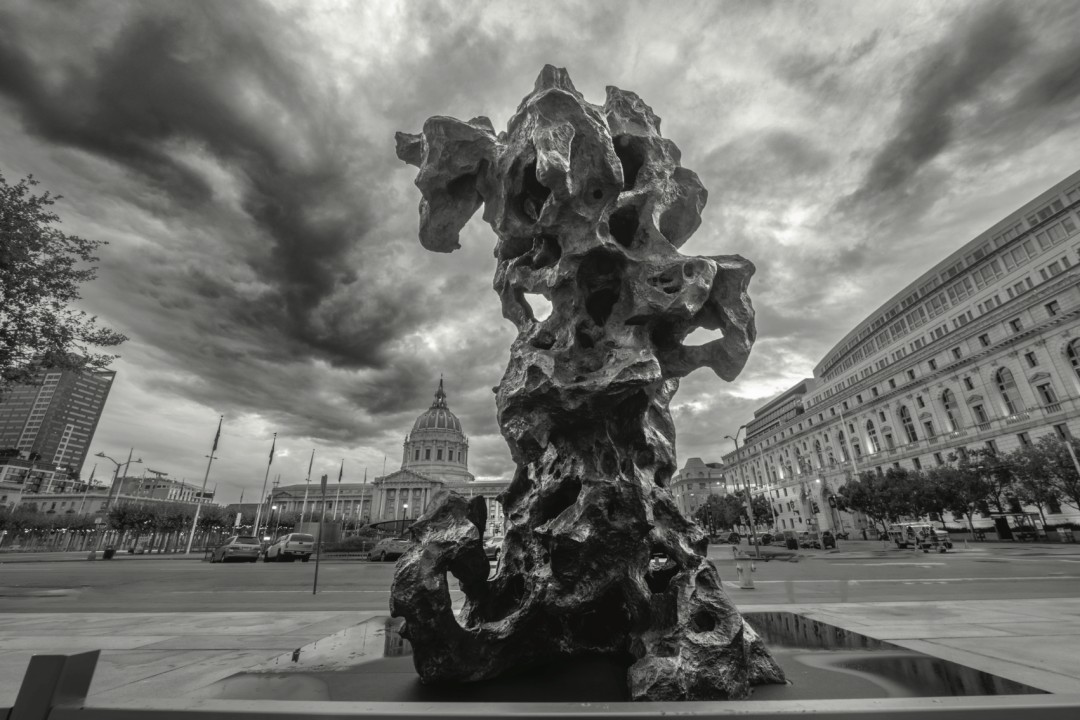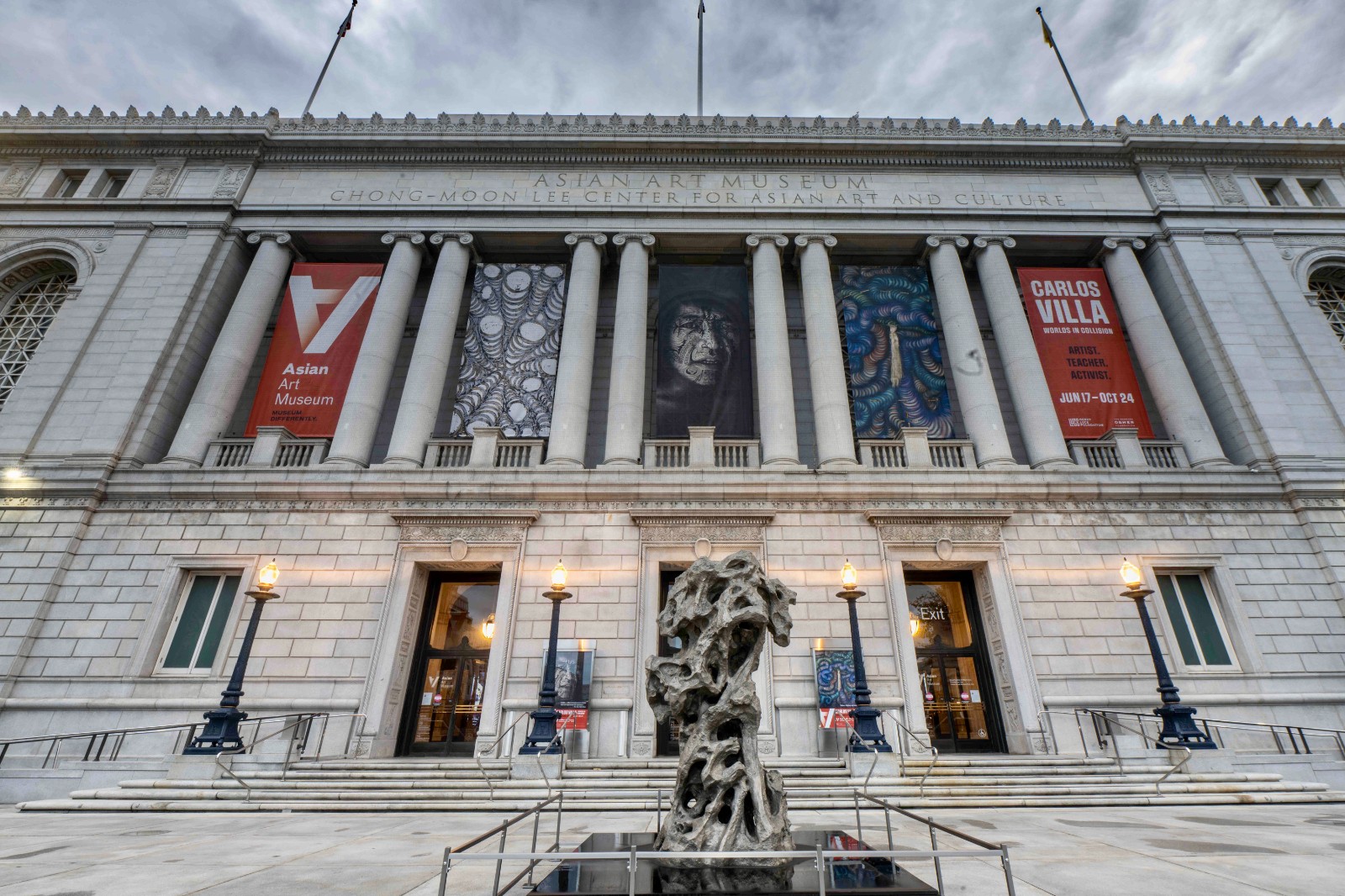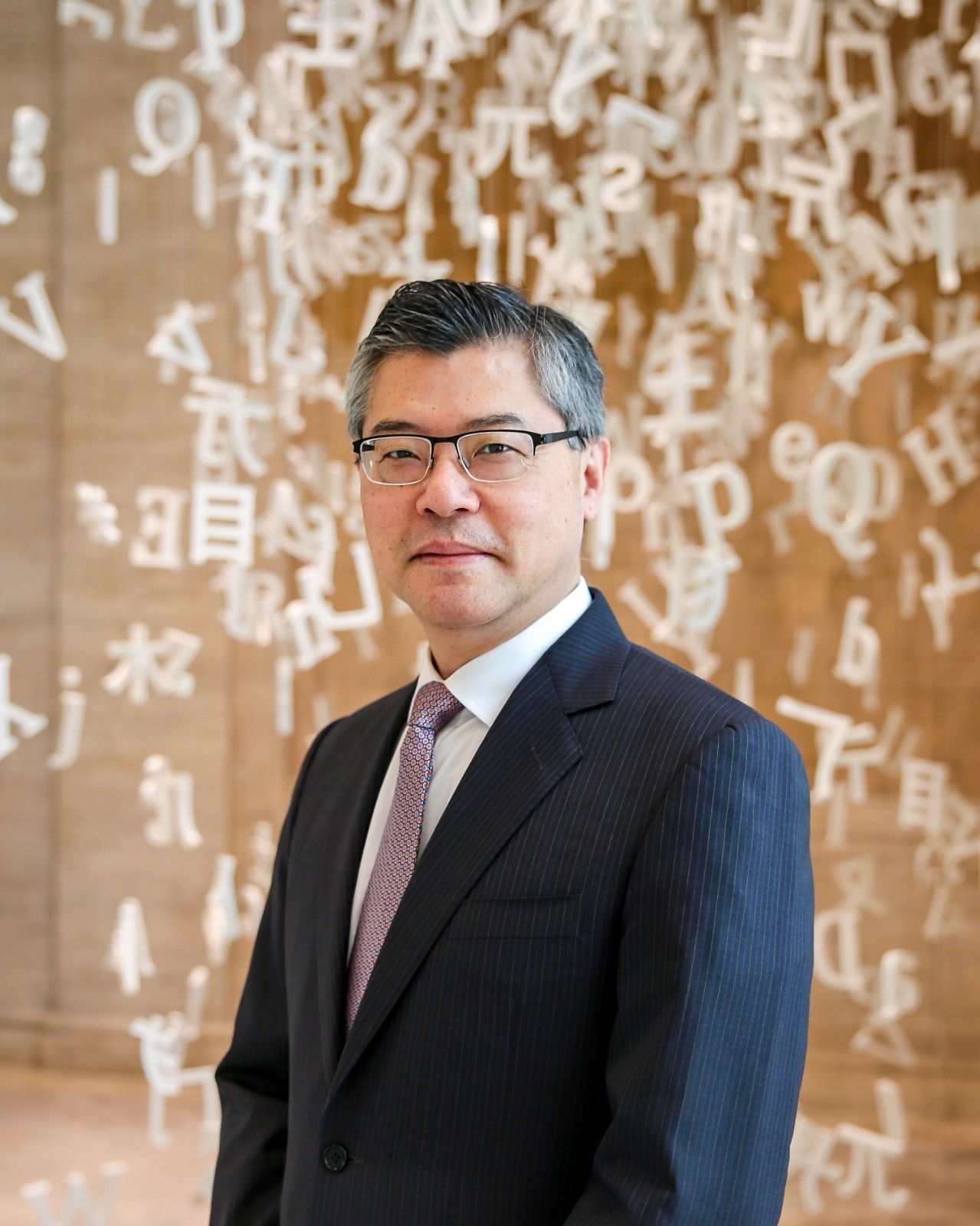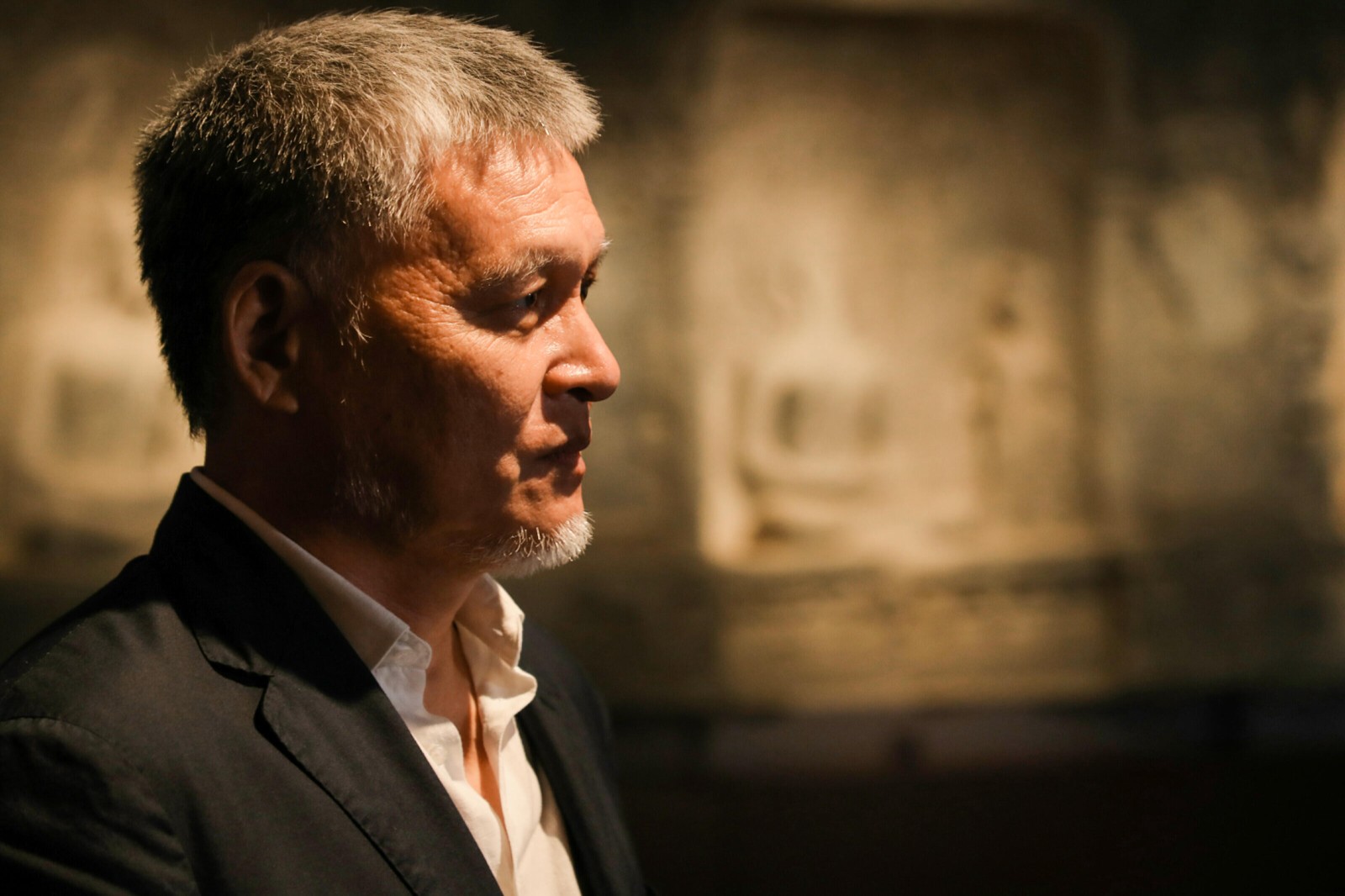Following Your Dog by Yoshitomo Nara that debuted at the Asian Art Museum in 2019, Taihu Rock—East Wind II created by artist Ren Tianjin as the latest rotating sculpture, made its debut at the plaza facing the Main Entrance of Asia Art Museum of San Francisco.

Taihu Rock—East Wind II made its debut at the Osher Plaza facing the Main Entrance of Asia Art Museum in San Francisco. Photo by Harry Williams.
Shaped to resemble cursive Chinese calligraphy spelling out “east wind” (dongfeng, 東風(fēng)), the 8-foot-tall (2.5 meters high) Taihu rock sculpture is made of nickel silver and it erupts from its two-dimensional written origins into three dimensions like an illustration in a pop-up book. This phrase references a Chinese idiom that encourages total preparation, in case a critical element is missing: “Everything is ready except the east wind.”1 Through the deconstruction and reorganization conducted by the artist, these two different dimensions of traditional Chinese art have received a completely new expression through the sculptural presentation. This transformation has succeeded in making “calligraphy art intervene in a Western context in a more acceptable way,” commented by Jay Xu, Director and CEO of Asian Art Museum, on the creation of Ren Tianjin at the seminar held by the Hangzhou International Modern Calligraphy Festival, and his creation forms some “calligraphy that takes place in the context of the world.”
 Taihu Rock—East Wind II made its debut at the Osher Plaza facing the Main Entrance of Asia Art Museum in San Francisco. Photo by Harry Williams.
Taihu Rock—East Wind II made its debut at the Osher Plaza facing the Main Entrance of Asia Art Museum in San Francisco. Photo by Harry Williams.
The expressive imagination of Taihu rock has almost become an artistic behavior in traditional Chinese garden culture, as the huge tension between the rich and explainable forms contained in the unique texture and shape of Taihu rock and artificial carving has constituted Ren Tianjin’s exploration in the traditional art concept of “Taoism follows nature” in the process of making calligraphy three-dimensional. While enabling the spectator to experience more dimensional information, he draws on an abstract artistic language to realize the reconstruction of the classical semantics in the East. This bold reconstruction means that “it cuts, splits, reorganizes, superimposes the external nature of the whole and the partial, stability and rhythm, abstract forms and representational texts,” said Prof. Shao Yiyang from the Central Academy of Fine Arts. Thus it was externalized into a new artistic language and trans-boundary innovative imagination.

Jay Xu, Director and CEO of Asian Art Museum and artist Ren Tianjin were at the installation scene of Taihu Rock—East Wind II.
Relying on his abundant experience in politics, economy and cultures from the East through to the West as well as in the business management and artistic practices over the past decades, he has absorbed the essence from the Eastern and Western cultures and converged it in his calligraphy and sculptures. His creation presents an organic combination of international modern art language and Eastern traditional art spirit which has transcended the boundaries between the East and West, between the traditional and contemporary cultures. This is exactly due to his global artistic vision, which opens up a novel perspective for him to seek a contemporary art practice with a traditional aspect. Also it is with this “contemporary-oriented tradition” that his work has produced some artistic conceptual resonance with the Asian Art Museum which aims to present Asian art and traditional art with a contemporary look and strives to present Asian art in the 21st century to the audience.
In the interview conducted by CAFA ART INFO, Jay Xu, Director and CEO of Asian Art Museum and artist Ren Tianjin talked about the eventual significance of Taihu Rock—East Wind II at the Main Entrance of Asian Art Museum as well as the details on how he created the work.

Jay Xu, Director and CEO of Asian Art Museum in San Francisco
Q: The Asian Art Museum of San Francisco, from a general impression, houses one of the most comprehensive Asian art collections in the world, especially from China. What considerations did you have before you chose Taihu Rock—East Wind II to locate it on the Osher Plaza.
Jay Xu: Our collections of traditional art are definitely an advantage of the Asian Art Museum but we have also been committed to expanding and collecting contemporary art. Ren Tianjin’s Taihu Rock—East Wind II as a contemporary artwork, has both a profound traditional cultural heritage integrating sculpture with calligraphy, and a combination of two traditional Chinese art forms with Taihu rock and calligraphy, thus it becomes a vivid contemporary artwork and this is also a well constructed experiment. Judging from the characteristics of the Asian Art Museum, it can be said that the Asian Art museum bridges the cultures of Asia and North America and contributes to cultural communication. Taihu Rock—East Wind II is a beautiful metaphor that we do appreciate.
Q: What’s the position of the Asian Art museum in the mainstream of American culture? What kind of influence do you have?
Jay Xu: We are one of the most important institutions which promote Asian art and culture in North America. In 1971 when the American team of Ping Pong visited China which was later called “Ping Pong Diplomacy”. From 1974 to 1975, a spectacular archaeological art exhibition from China toured to three museums in the United States, including Ma Ta Fei Yan (A Running Horse Stepping on a Swallow), one of the Chinese cultural symbols, and this became a stepping stone for cultural diplomacy in the establishment of diplomatic relations between China and the United States. Historically, major cultural exhibitions from China have generally been held in the Asian Art Museum including the last stop of the exhibition I just mentioned. In recent years, we hope to expand the field of contemporary art on this basis and present contemporary Asian art in the 21st century which also includes the creations by contemporary Asian-American artists.
Q: From Your Dog by Yoshitomo Nara to Taihu Rock—East Wind II by Ren Tainjin, although they both belong to Asian contemporary art, what is the difference in the focuses of your choices?
Jay Xu: The work in front of the main entrance of the Museum must be contemporary art, which is the basic choice of our thinking, and our purpose is to present a new look to our audience. At the same time, the work should also be related to traditional culture and be able to attract attention from spectators. For example, Your Dog by Yoshitomo Nara, which is very large, very cute and very popular with the audience, previously exhibited works including the Dragon Fortune by Taiwanese artist Hung Yi. Inscribed on the body are abundant Chinese expressions of good fortune, with the dragon’s shape like a fish, Dragon Fortune evokes Chinese folklore about carp transforming into dragons,2 which was also widely loved by everyone. We hope to attract more visitors to find more at the Asian Art Museum through the sculptures on the Osher Plaza.
Q: Compared with Your Dog by Yoshitomo Nara,, this work is relatively abstract, especially in the form of sculpture with the addition of abstract forms of calligraphy, will it increase difficulty with comprehension for the audience?
Jay Xu: Yes, this is also an inevitable challenge, but I think the work mainly attracts the audience with its image, stimulating their curiosity through the modeling, and naturally leading people to explore it personally, and we will also have an instruction in the future to elaborate on it. Actually, many spectators may not be able to directly realize the connection between Taihu Rock—East Wind II and Chinese gardens, nor did they understand that Taihu rock is an ornamental stone in traditional Chinese gardens, as they regard it as a purely abstract work.
“Taihu rock” refers to the limestone formations found in Lake Tai in Jiangsu province. Historically, this was one of the main sources for scholar’s rocks, water-eroded stones that have been prized by Chinese scholars since the Tang dynasty (618–907). The hollowed-out, perforated form of Ren’s sculpture evokes a similar reverence for the natural world and its processes. But as long as the work is concrete enough to stimulate the curiosity of the audience and draw them in, it can provide them with a terrific opportunity to appreciate the deeper significance of culture.
 Taihu Rock—East Wind II made its debut at the Osher Plaza facing the Main Entrance of Asia Art Museum in San Francisco. Photo by Harry Williams.
Taihu Rock—East Wind II made its debut at the Osher Plaza facing the Main Entrance of Asia Art Museum in San Francisco. Photo by Harry Williams.
Q: What visual path does the Asian Art Museum follow, linking Asia with the world, tradition and contemporary?
Jay Xu: The general exhibition orientation of Asian Art Museum focuses on three aspects: the connection between art and life, the connection between ancient and contemporary, the connection between Asia and the world, and the specific operation is not limited to any form and content, and is biased towards displaying contemporary creations with traditional aspects at the core.
We want to stick to no art forms, like teamLab, a digital art team from Japan, whose first exhibition in the U.S. was held at Asian Art Museum, which shows a completely different impression from an art museum that showcases ancient Asian artifacts. We are willing to try various forms, as long as it can link the contemporary and traditional, such as teamLab's visual experience is very avant-garde, but its artistic elements are completely from traditional Japanese art, in which the texts, flowers, patterns and other symbols are from traditional Japanese culture, the high-tech and traditional art are integrated to form a connection between the traditional and the contemporary.
Secondly, Asian Art Museum also provides a platform for Asian-American artists to showcase their works, which is one of its missions. We present exhibitions displaying the life and cultural history of Asians in the United States, connecting art and life, and also connecting cultures on a larger scale, so as to connect Asia and the world. We also curate exhibitions that showcase the interaction and impact between Asian and other regional cultures. Through the display of interactive exchanges among cultures, everyone is encouraged to appreciate the important role of Asia in global culture.
 Ren Tianjin, Doctor of Philosophy in Arts Studies from China Academy of Art and Postdoctoral fellow/researcher a the University of California, Berkeley.
Ren Tianjin, Doctor of Philosophy in Arts Studies from China Academy of Art and Postdoctoral fellow/researcher a the University of California, Berkeley.
Q: On August 31st 2022, the Asian Art Museum of San Francisco installed your sculpture Taihu Rock—East Wind II in its 2019 collection at Osher Plaza, facing the main entrance of the Museum. Will the change of venue make this work produce publicity of a different artistic nature ?
Ren Tianjin: The Asian Art Museum of San Francisco is the largest Asian art museum in the United States, and I feel honored that Taihu Rock—East Wind II can be exhibited here which is an affirmation. Osher Plaza, the main entrance of the Asian Art Museum of San Francisco, faces San Francisco City Hall, where the work is displayed, clearly expanding its common approach and interactivity. We all know that a square is a place where people gather, thus many relationships among people, between people and the environment, between people and society can be detected here, a sculpture placed in such an open space can cause a completely different effect from that when it is placed in the Museum, which inevitably triggers people’s attention and discussion.
Q: When did you start to work on Taihu Rock—East Wind II? Where did the creative inspiration come about?
Ren Tianjin: I started to work on it in 2017, when I lived in Hangzhou for a long time, I initially wanted to find a piece of Taihu rock to put in my yard, but I never found a particularly satisfactory one, so I came up with the idea of creating my own. In fact, there are many artists who use Taihu rock as the theme of creation, but my own wish is particularly simple, that is, to find a piece of Taihu rock that I am satisfied with.
Since the Ming Dynasty, the Taihu rock has been a symbol of the literati and a carrier of Chinese culture. I studied for a Doctor of Philosophy in Arts Studies under the guidance of Prof. Wang Dongling at the China Academy of Art, and during my study on campus, I conducted systematic aesthetic editing and edification from Eastern art. The courtyards and architecture of Hangzhou left a deep influence on me, so in my creation, multiple feelings are blended together, and in the sculpture Taihu Rock—East Wind II, the traditional Chinese calligraphy art and the structure of contemporary sculpture are organically combined, in a both deconstructed and reconstructed way in my work.
How to present two-dimensional calligraphy in the form of three-dimensional sculpture is a concept that has always run through my creation. I consulted a large number of paintings about Taihu rock, and finally extracted some aesthetic inspiration from the ancient paintings of the Qing Dynasty to ensure that this artistic fusion was not aesthetically prominent. At the same time, I combined the calligraphy work “East Wind” that I exhibited at the China Academy of Art as the material for my creation.
In the selection of materials, considering the originality of the stone, I chose nickel silver which texture is close to that of Taihu rock. The series of works has also been collected by the School of International Education at China Academy of Art, Ping An Group, Dong Yuan Group, as well as well-known enterprises and museums at home and abroad.
Q: The organic integration of calligraphy and sculpture is indeed a unique perspective on artistic creation. How did you come up with the idea of connecting these two?
Ren Tianjin: My PhD supervisor Wang Dongling, who is an art creator who walks through traditional and contemporary art. I followed Wang Dongling and saw his concept and attitude towards contemporary art, so my Taihu rock is integrated into the text, which is also related to my experience of studying at the China Academy of Art.
The transformation of the medium from calligraphy to sculpture is a creative path that I have been exploring continuously. Chinese calligraphy is a shining pearl in the history of Eastern culture, but it is precisely the most difficult art for the ordinary audience in the West to accept. The reason is that Western spectators who do not understand Chinese characters find it difficult to understand the meaning of Chinese calligraphy, because it is strange and difficult to approach so they often reject it. With Chinese calligraphy cutting into sculpture creation, the word “East Wind” in Eastern calligraphy is organically rubbed into the shape of sculpture commonly accepted by Western art. The organic combination of flat calligraphy and three-dimensional sculpture is also an innovation with the combination of Eastern culture and Western art, so that this work not only has the artistic characteristics of Eastern and Western cultures at the same time, but it also produces an intercommunal artistic appreciation. In this way, the promotion of Eastern culture in the form of artistic expression that is easily accepted by a Western audience can make it easier for them to accept and thus generate their interest in exploring Chinese art.
Q: What do you think about the relationship between traditional Chinese art and contemporary art? Now that many contemporary artists are trying to draw nourishment from traditional Chinese art, how do you see the transformation of traditional language into the context of contemporary art?
Ren Tianjin: I think contemporary and traditional art should be “interspersed.” In the case of Wang Dongling, his calligraphy works are regarded as contemporary art in domestic and foreign academic circles. For example, his “chaotic writing” breaks the original rules between words and lines, and looks like a painting from a distance, but it is actually calligraphy, if each word is singled out from the work, or the writing process is recorded in slow motion, each word is standard traditional cursive. But in the art world, his work is interpreted more from a contemporary perspective than from the perspective of traditional calligraphy. Therefore, although the works of “chaotic writing” are regarded as contemporary art, they are inextricably linked to traditional culture.
I think contemporary art is an artistic phenomenon that has flourished on the basis of our traditional culture. The long and splendid traditional culture has cultivated diversified and innovative contemporary art, and they in turn have better inherited traditional culture.
Interviewees: Jay Xu and Ren Tianjin
Interviewer and Editor: Mengxi
Edited and translated by Sue/CAFA ART INFO
Image Courtesy of the Artist.
The Exhibition Introduction on Taihu Rock—East Wind II from Asian Art Museum.
The Exhibition Introduction on Hung Yi: Dragon Fortune from USC US-China Institute.
Taihu Rock—East Wind II




























